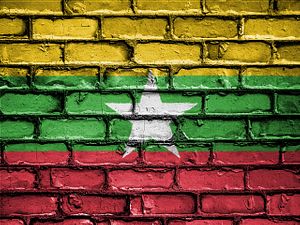Sebastian Strangio

Myanmar’s political crisis is entering a new and more complex phase as a raft of new armed militias arise to resist the country’s military junta, according to the latest report from the International Crisis Group (ICG). Since the military’s seizure of power on February 1, the junta’s crackdown on protesters and the broader civilian population has prompted violent resistance, including the formation of civilian militias in several corners of the country.
“The swift emergence of militias, and their capacity to evolve from loosely coordinated groups of local people into more structured, better armed, and sustainably funded forces, likely marks a new phase of Myanmar’s decades-old civil war,” states the ICG report, which was released yesterday.
Despite being armed mostly with hunting rifles and other makeshift weapons, these groups have inflicted significant casualties on the security forces, who have struck back with characteristic overkill, barraging populated areas with artillery, airstrikes, and helicopter gunships.
For example, the military’s recent attacks on Mindat in Chin State and Demoso in Kayah State – both important centers of militia activity – have collectively driven tens of thousands of men, women, and children from their homes.
According to ICG, this new crop of armed groups – among the most prominent are the Chinland Defense Force (in Chin State), Karenni Nationalities Defense Force (in Kayah State), and Kalay Civil Army (in Sagaing Region) – reflects the increasingly revolutionary agenda of the anti-junta forces. These no longer aim for a simple return to the status quo ante, but rather for “the Tatmadaw’s disbandment and its replacement by a new armed force that is not dominated by the Burman ethnic majority.”
Civilian militias have met the most success in regions with existing militias or ethnic armed groups, or strong traditions of hunting, where basic weapons are easy to come by and many men have intimate knowledge of local terrain. The report adds that many of these areas have seen no active conflict in recent years, “meaning the Tatmadaw has little established military and intelligence capability there.”
The report also notes the parallel emergence of urban militias, such as the group that engaged in a firefight with Tatmadaw soldiers in Mandalay, Myanmar’s second largest city, last week. Similarly, recent months have seen increasing instances of attacks in urban areas, including “improvised explosive devices, arson and killings of administrative officials and suspected regime informants.”
The report suggests that given the depth of grievance against the military junta, drawing on decades of neglect and racism, the new militias are unlikely to fade away. They are thus set to add an additional layer to the complexity of Myanmar politics, complicating the junta’s attempts to consolidate its hold on power.
“They constitute new fronts for the Tatmadaw, which will probably keep blindly lashing out at civilians, as it has done repeatedly in the past when fighting many of the country’s ethnic armed groups,” the report predicts.
Whether these new forms of resistance are ultimately successful in preventing the junta from strengthening its hold on power is less clear. The ICG report points out that while many of these civilian militias express support for the National Unity Government set up in April to function as an internal government in exile, “they are not under its command or control.”
It also notes that previous militias have enjoyed “privileged access” to resources within the political economy of Myanmar’s conflict zones, suggesting that they could evolve in ways that are in tension with the democratic aims of the anti-junta resistance. As it argues, “Experience from other parts of the country shows that such groups can provide protection for residents but can also become a source of insecurity for them, as well as an economic burden.” For instance, as ICG noted in another report from 2019, armed militias have long established themselves as key players in the booming methamphetamine trade in Shan State.
As such, this development heralds the increasing fragmentation of Myanmar state authority into smaller shards of jurisdiction under the sway of local armed groups. While this has been the case in Myanmar’s conflict zones for decades, the junta’s heavy-handed suppression of popular discontent points to the generalization of this state of civil war and state fracture to progressively larger swathes of the nation.
No comments:
Post a Comment